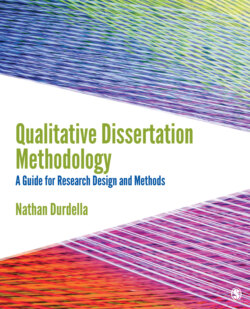Читать книгу Qualitative Dissertation Methodology - Nathan Durdella - Страница 26
На сайте Литреса книга снята с продажи.
Putting Together Your Qualitative Dissertation Advising Chair and Committee
ОглавлениеWhile some doctoral program contexts structure dissertation advisor assignment to students—either directly assigning a chair or major professor to you, directly assigning a chair and committee to you, assigning you to a dissertation advising group with a chair and students, or appointing a chair that you have had some say in selecting—you still need to consider with whom you can work best to support your dissertation research work. Even if you have no control over who serves as your chair and/or even if you already have been assigned or selected a chair, knowing a bit more about what a chair means for your qualitative dissertation study can serve you well not only as you develop your methodology chapter, but also as you implement your study. With multiple roles in doctoral student lives, faculty advisors are essential to meaningful student experiences and outcomes. At the dissertation level, the faculty advisor as “chairperson of the committee usually has broad power and influence throughout the process of completing the dissertation . . . [so] the selection of a chairperson for your project is a very important decision” (Reis, 2014). But the dissertation chair is so much more than simply a research supervisor. Indeed, a chair tends to serve in multiple roles—so the selection of someone who can offer more than a supervisorial role benefits students. Of course, we know that at the dissertation phase of a program, faculty–student advising tends to intensify and the frequency of interaction increases—leading to more time together and more collaborative efforts as a research partnership. Within program contexts, this is a critical time in students’ development, so a productive, supportive, and caring relationship with faculty advisors as dissertation chair often translates into not only degree and dissertation research progress but also professional growth and career opportunities as a researcher.
Table 1.1
Note that this timeline may not apply directly to your program or advising contexts and can be selectively used as a basic guideline to set timeline goals and dates for deliverables of dissertation research products. Where dissertation formats vary and time-to-degree extend beyond what appears here, adapt what appears in the table to meet your specific research and advising needs.
Faculty Contact With Students in Graduate Programs
From pre-program entry to orientation, faculty members most often are the first line of contact for students in a graduate program. Indeed, graduate students meet and work immediately and directly with faculty. In sharp contrast, a system of advising that spans student and academic affairs—from admissions and records operations and assessment programs to new student orientations, large-scale first-year advising initiatives, and individual academic advising in the majors— often pushes undergraduate students to interact with college and university staff before they ever see or meet with faculty. While transitioning to a graduate program, faculty tend to be the first to welcome students and run orientations, describing campus life and department culture, discussing program and degree requirements, and structuring advising as a relationship with faculty.
Like other program policies and practices, the selection of a dissertation chair is typically documented in program handbooks, a discussion that gives us a sense of who this person is to a student. For example, the University of New Orleans (p. 19) states that the “[s]election of a dissertation advisor (or major professor or chair) is initiated by students and is determined by mutual agreement of the student, the faculty member, and the Ph.D. Graduate Coordinator” (Department of Planning and Urban Studies/College of Liberal Arts, 2013). Similarly, at California State University, Northridge, the doctoral program handbook mentions that dissertation chair selection is “based on candidate requests and faculty availability, eligibility, and expertise” (California State University, Northridge, 2014, p. 26). A quick look at just these two program handbook statements presents a compelling case for a dissertation chair selection process that is regulated, ordered, and deliberate—at least from the program perspective. But what do you need to know as you consider with whom to work? What program handbooks generally omit, though, is the process and criteria that students should use to select a chair and committee. Indeed, using a systematic process to inform decisions about whom to work with will support one of the broadest goals of such an approach: gathering lots of information (Clark, 2006).
